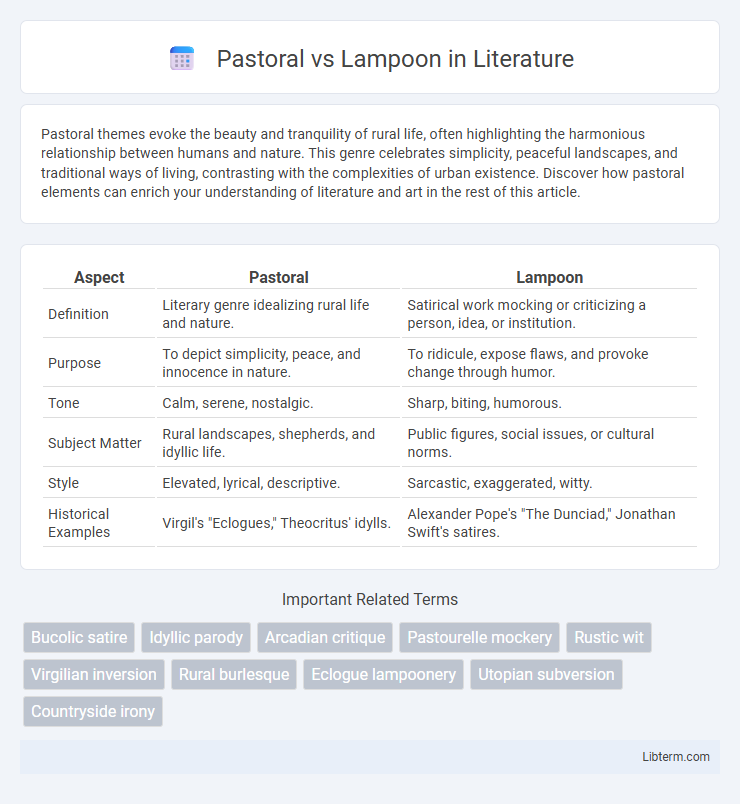Pastoral themes evoke the beauty and tranquility of rural life, often highlighting the harmonious relationship between humans and nature. This genre celebrates simplicity, peaceful landscapes, and traditional ways of living, contrasting with the complexities of urban existence. Discover how pastoral elements can enrich your understanding of literature and art in the rest of this article.
Table of Comparison
| Aspect | Pastoral | Lampoon |
|---|---|---|
| Definition | Literary genre idealizing rural life and nature. | Satirical work mocking or criticizing a person, idea, or institution. |
| Purpose | To depict simplicity, peace, and innocence in nature. | To ridicule, expose flaws, and provoke change through humor. |
| Tone | Calm, serene, nostalgic. | Sharp, biting, humorous. |
| Subject Matter | Rural landscapes, shepherds, and idyllic life. | Public figures, social issues, or cultural norms. |
| Style | Elevated, lyrical, descriptive. | Sarcastic, exaggerated, witty. |
| Historical Examples | Virgil's "Eclogues," Theocritus' idylls. | Alexander Pope's "The Dunciad," Jonathan Swift's satires. |
Introduction to Pastoral and Lampoon
Pastoral literature idealizes rural life and nature, emphasizing tranquility, simplicity, and harmony with the environment. Lampoon, in contrast, is a form of satirical writing that sharply criticizes individuals or institutions through humor, irony, and exaggeration. Understanding the pastoral genre involves exploring its themes of idyllic landscapes and innocence, while lampoon focuses on sharp social commentary and ridicule.
Defining Pastoral: Origins and Characteristics
Pastoral literature originates from ancient Greek and Roman traditions, depicting idealized rural life and nature, often emphasizing themes of simplicity, innocence, and harmony. Its characteristics include the use of shepherds or rural characters who embody peacefulness and moral virtue, contrasted against the complexities of urban or court life. This genre typically employs lyrical language and imagery that celebrates the countryside as a refuge from societal corruption.
Understanding Lampoon: Satire and Mockery
Lampoon employs satire and mockery to expose flaws, vices, and absurdities in individuals or society through exaggerated humor and irony. This literary genre uses sharp wit to ridicule its subjects, often targeting public figures or cultural phenomena to provoke reflection or criticism. Unlike pastoral works that idealize rural simplicity and harmony, lampoons serve as a vehicle for social commentary and pointed critique.
Historical Development of Pastoral and Lampoon
The historical development of pastoral literature traces back to ancient Greece, with Theocritus's idylls inspiring Virgil's Eclogues, depicting idealized rural life as a contrast to urban complexity. Lampoon, evolving from classical satirical poetry, gained prominence in the Renaissance as a sharp, often personal, critique delivered through humor and irony targeting individuals and societal norms. Both genres reflect shifting cultural and political landscapes, with pastoral idealizing nature and simplicity, while lampoon exposes folly through biting wit.
Key Themes in Pastoral Literature
Pastoral literature explores idealized rural life, emphasizing themes of nature's purity, simplicity, and harmony as a contrast to urban corruption and complexity. Central motifs include the shepherd's innocence, the celebration of seasonal cycles, and the depiction of love and poetic inspiration in a natural setting. These themes underscore a yearning for a peaceful, untainted existence, often serving as a critique of societal and political corruption found outside the pastoral world.
Techniques and Devices in Lampoon Works
Lampoon works employ satire, irony, and exaggeration to ridicule or criticize subjects, often using hyperbole and caricature to amplify flaws humorously. Techniques such as parody, wit, and sarcasm serve to expose societal follies or individual vices, creating a sharp contrast to the idealized and harmonious depictions found in pastoral literature. Lampoon frequently uses vivid imagery and pointed language to provoke laughter while conveying a critical message.
Comparing Purpose: Idealization vs. Critique
Pastoral literature idealizes rural life, presenting nature as serene and harmonious to evoke nostalgia and escape from urban complexity. Lampoons serve as satirical critiques, exaggerating and mocking societal flaws to provoke thought and challenge prevailing norms. While pastorals celebrate simplicity and virtue, lampoons expose absurdity and vice, reflecting opposing purposes through contrasting tones and themes.
Notable Examples of Pastoral and Lampoon Genres
Notable examples of the pastoral genre include Virgil's "Eclogues," which idealize rural life through shepherds' dialogues, and Edmund Spenser's "The Shepherd's Calendar," depicting rustic simplicity and harmony with nature. In contrast, lampoon examples feature Jonathan Swift's "A Modest Proposal," a biting satirical work using irony to critique social issues, and Alexander Pope's "The Dunciad," which mocks literary incompetence with sharp humor. These works highlight the pastoral's emphasis on serene, idealized rural settings versus the lampoon's focus on sharp, humorous social or political criticism.
Cultural Impact and Relevance Today
Pastoral literature, rooted in idealized rural life and nature, continues to influence contemporary environmental movements and artistic expressions that emphasize simplicity and harmony with nature. Lampoon, as sharp satirical writing targeting social and political flaws, remains vital in modern media and political discourse, shaping public opinion and cultural criticism. Both forms maintain cultural relevance by reflecting societal values and challenges, with pastorals fostering nostalgia and lampoons driving accountability.
Conclusion: Navigating the Line Between Reverence and Ridicule
Pastoral literature idealizes rural life with reverence, emphasizing harmony and simplicity, whereas lampoon employs satire to ridicule and expose flaws in social or literary subjects. Navigating the line between these styles requires a nuanced understanding of tone and intent, ensuring that critique remains insightful without descending into disrespect. Effective use of pastoral elements in lampoon can create a balanced commentary that honors tradition while challenging its shortcomings.
Pastoral Infographic

 libterm.com
libterm.com